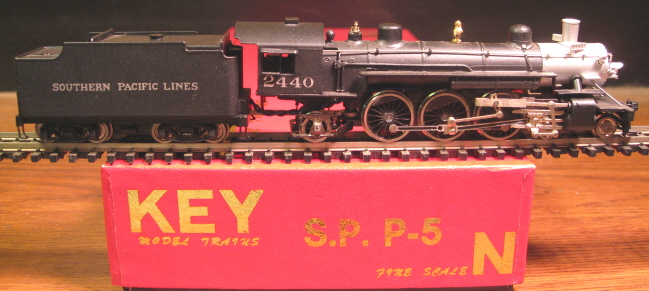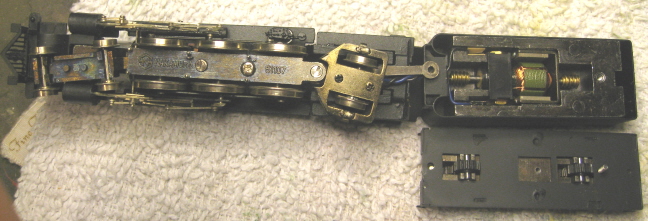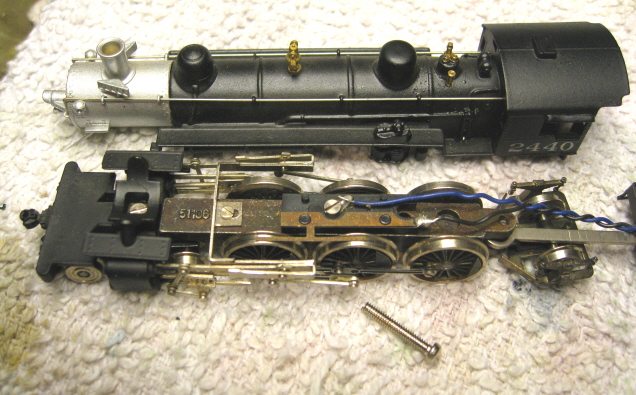


Introduced: 1982 (Great Northern H-4) and 1983 (Southern Pacific P-5)
Key's 1982 GN H-4 Pacific was that firm's first N scale import. Their Southern Pacific P-5 came out in the following year. And since the two models share the same basic locomotive chassis and tender-drive mechanism, I'm going to go ahead and cover them both here (given the cost of these birds, being able to kill two with one stone is always a plus).

As indicated above, the motor is actually contained within the tender. To get at it, you simply remove the two end screws on the bottom of the tender chassis (the center screw need not be removed - all it does is hold the gear "bottom plate" in place). The tender "body" consists of the shell and a big, heavy hunk of metal. And I'll be damned if I know how the two are joined - Glue? Solder? Your guess is as good as mine. In any case, they are permanantly wedded to each other. The motor, driveshafts and worm gears all nestle inside pockets inside said chunk of metal (not affixed in any way). However, pickup wires from the engine to the motor are routed through a small hole in the front of the tender. Consequently, the tender and engine cannot be separated (not without desoldering said wires first).
The motor is an open-sided, straight-wound 5-poler (no flywheels). The worms drive one axle per tender truck (and with all four driven wheels being equipped with traction tires). The engine itself is just along for the ride - pushed by the tender, and that's it. Right-rail pickup is provided by all three right-side drivers, the pilot truck, the trailing truck, and the two right-side tender wheels (the ones that don't have traction tires, that is). And from the "WTF?" department, left-rail pickup is provided solely by the forward two left-side drivers (courtesy of a couple of wipers). A twisted pair of insulated wires transfers left and right-rail current from the engine back to the motor. To free the engine shell from its chassis, simply remove the center bottom-plate screw -

Apart from the two brass worms, all gearing is plastic. The pilot coupler is a dummy (non-operational) knuckle. There is no coupler on the tender, although a pre-drilled hole is provided for screwing in some sort of Micro-Trains coupler assembly. There is no lighting. All wheels are relatively low profile, so no specific problems on Code-55 rails. Having said that, this locomotive does tend to "ka-chunk" along when faced with rail joiners, turnouts and suchlike (even on Code-80). All of the wheels on mine are in gauge, so I'm not really sure what that's all about.
One major difference between the GN H-4 and the SP P-5 is the plastic used in the idler gears (the gears between the worms and the axle gears). The H-4 has white plastic idler gears, whereas the P-5 idler gears are black plastic. And unfortunately, said white plastic gears are notoriously prone to failure - something I can certainly attest to as I have an H-4 where one of the idlers split. Fortunately, NWSL sells replacement gears for these models (or at least they did as of this 2013 writing). The catalog number is/was 2259-6.
These are nice looking models with fine paint and detailing. Unfortunately, performance is a bit of a mixed bag. On the plus side, they run reasonably quietly and respond smoothly to throttle changes. The gear action on the engine is flawless. And despite the odd pickup scheme, I haven't experienced any problems with stalls (even through turnouts). Slow speed performance is quite respectable, although the top-end speed is a bit higher than it needs to be. On the down side, I found mine to be pretty much useless on extremely sharp (9.75" radius) curves. The entire engine tends to tilt to the side on sharp curves, causing the cow-catcher to collide with the rail-heads. Consequently, any unevenness in track joints will bring this thing to a sudden halt.
Gear issues and other quibbling aside, the main deal-breaker here is that tender drive. All of those traction tires make for a very obvious and somewhat comical wobble as the tender chugs its way down the tracks. And one can only assume that removing said tires would simply result in a locomotive that can't pull anything. So, ultimately a bit of a shelf-queen.
Grade: C